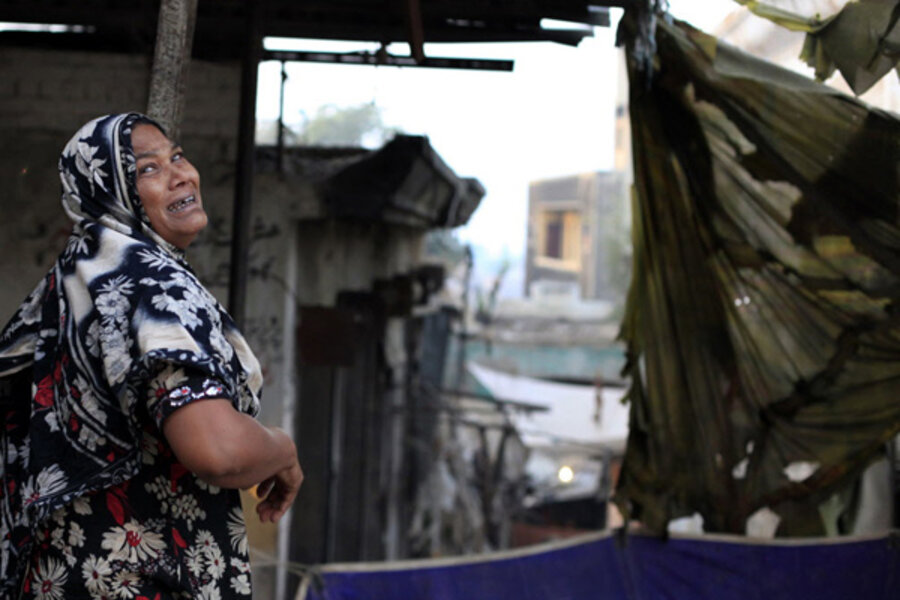In Pakistan, militant attacks on Sufi shrines on the rise
Loading...
| Karachi, Pakistan
Shrines in Pakistan are spectacles of devotional singing and dancing, colorful garlands, and decorative tokens of vows to Sufi saints, often festive spots for families to gather and devotees to perform. But under increasing threat by Al Qaeda-linked militants, they have also become danger zones.
More than 70 suicide attacks at shrines have killed hundreds of worshipers in Pakistan since 2005, but the attacks have escalated recently, and the revelry has been increasingly replaced by metal detectors, paramilitary troops, and shrapnel.
In October alone, the Pakistani Taliban were believed to have been behind the deaths of some 17 pilgrims and the injuring of 100 more in separate bombings in two cities.
The motivation for these attacks might get lost in international headlines, but they are an indication of the brewing cultural war for the direction of Islam in Pakistan.
From Iraq to Pakistan
That war has crossed borders. Attacks by militants on Shiite shrines in Iraq, it is believed, began as a way to exploit Shiite Sunni sectarianism. Since then, shrine attacks have been used in Pakistan by Al Qaeda-linked militants to edge out both moderate Sunnis and devout Shiites and push a militant-approved version of Islam on Pakistan, say analysts.
"They want to capture the country by imposing their militant ideology. They want to silence the [dissenting, moderate] voices by eliminating them. They want to frighten common men," says Lahore-based analyst and leading historian Mubarak Ali.
Who's who
Behind this extremist push are two strict branches of Sunni Islam: the Wahhabis and Deobandis. Members of Al Qaeda, the Afghan Taliban, and the Pakistani Taliban all generally belong to one of these though they hail from different countries. Both sects take a literalist approach to Islamic texts, are widely considered extremist, and view visiting shrines and worshipping saints as heresy.
The Wahhabi is the dominant faith in Saudi Arabia, while the Deobandi, a similar sect, is found in Pakistan and India. During the 1980s, Deobandis and the Wahhabis linked to help then-military ruler Zia-ul-Haq counter Shiite influence in the wake of the Iranian revolution.
They helped establish thousands of fundamentalist madrasas, mostly run by the religious political party Jamiat Ulema-e-Islam all over the country. It is believed that Osama bin Laden and Mullah Omar revitalized the links between the two groups during the current Afghan war.
Road block to extremism?
Sufis and moderate Sunnis belonging to the looser Barelvi school of thought, meanwhile, are the main roadblock for these stricter versions of Islam to establish hegemony in Pakistan. Barelvis believe in the linked and broken chain of spiritual leaders, reaching ultimately to the prophet Muhammad, who intercedes on their behalf with Allah.
Particularly infuriating for the Taliban is that the Barelvis are putting up a fight against a militant-approved Islam. Moderate Sunnis belonging to the Barelvi sect have formed an alliance against the Taliban and have been active in protesting the growing Talibanization and militant Islamism for the past year.
"Sufism is a way of life in Pakistan for centuries, unlike decades-old Islamic fundamentalism or militant Islam," says Syed Munir Shah, a Sufi scholar. "They [militant Islamists] want to rule the world by guns and we [Sufis] try to rule the hearts and souls by spreading a message of peace and religious harmony. Sufism is the strongest shield against the militant face of Islam." Still, the shrine attacks are aimed at polarizing Pakistani society, say experts. And militant organizations appear to be stepping it up.
Sectarian violence
Indeed, in addition to such earlier targets as Western institutions, the Pakistani Army, and security agencies advancing the war on terror, Al Qaeda and the Pakistani Taliban have homed in on Islamic practices of which they disapprove.
The biggest shrine in Islamabad, Bari Imam, was attacked in 2005, killing 30. Since then, big shrines in Peshawar, Lahore, and Karachi have also been targeted, among others across the country.
In December 2008, a spiritual leader named Pir Samiullah belonging to the Barelvi sect, along with seven colleagues, was killed by Taliban militants in Swat Valley for dissenting. His followers buried him, but the Taliban exhumed his body and hanged it publicly. "Fighting us is like negation of [the] Quran," the then-Taliban commander was quoted as saying.
Playing off mixed feelings about US intentions in the region, Al Qalam, a publication of banned militant outfit Jaish-e-Mohammed, recently warned of Americans donating dollars to strengthen the Barelvi school.
"They [the US] want to use the successors of shrines as their partners to counter jihadis.… This is an attempt to destabilize Pakistan as Americans are holding secret meetings with them … it is conspiracy against not just the Mujahideen but also against Pakistan."
In the end though, mainstream Pakistan won't fall for it, says the historian, Mr. Ali, "I believe [the militants' efforts] won't be successful because cultural traditions and values here don't approve of militant Islam."





